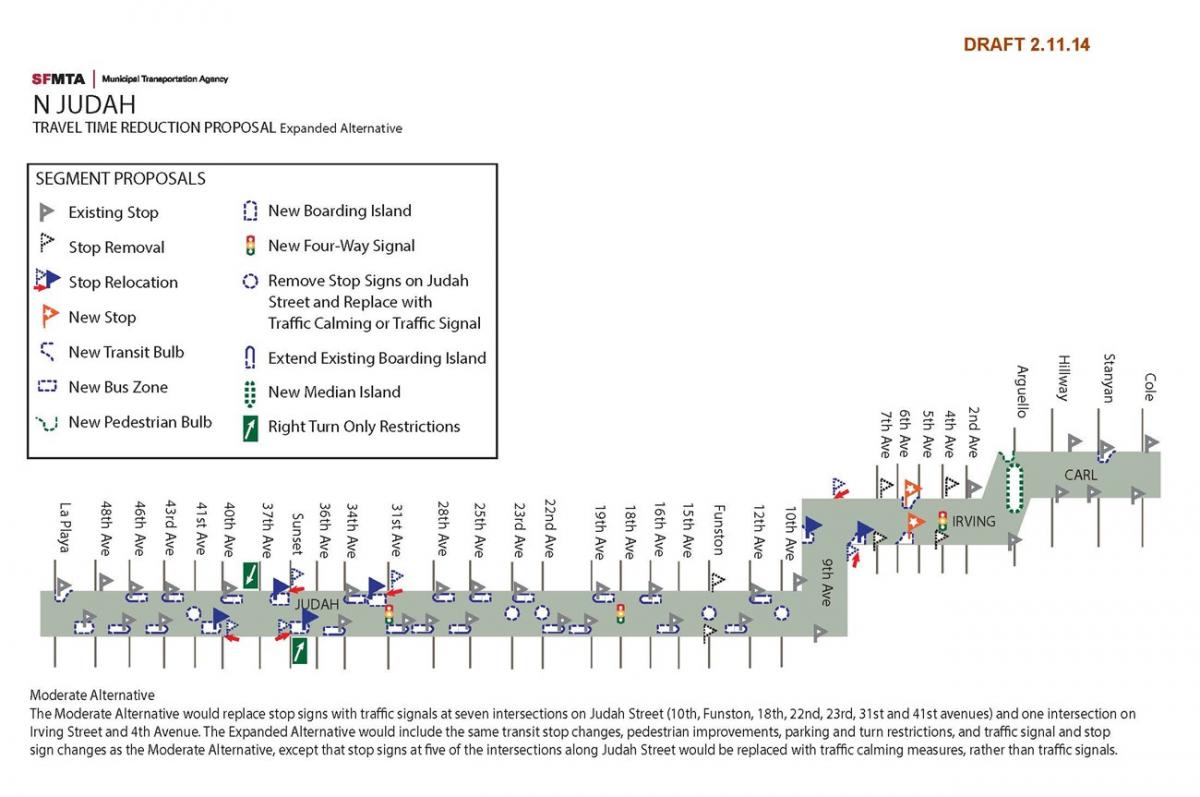Project Introduction
The N Judah Muni Metro corridor is part of SFMTA’s Muni Forward Rapid Network where we are building transit priority lanes with efficient stop spacing to move vehicles quickly along their routes. We’re also creating better boarding zones to make it safer and faster for passengers to get on board and make it easier to find our stops and shelters with improved signage.
What's included in the N Judah Rapid Proposal?
Key Features:
- Replacing all-way stop-controlled intersections with traffic signals or traffic calming measures at eight intersections.
Currently, the N Judah is delayed by having to come to a complete stop at multiple intersections with stop signs. These stop signs could be replaced with traffic signals equipped with transit signal priority. This would reduce delay at intersections because the signals could be programmed to hold green lights for approaching trains.
Alternatively, traffic calming measures such as corner bulbs, raised crosswalks, and sidewalk extensions could be installed to provide improved pedestrian safety by reducing the roadway crossing distance, making people waiting to cross the street more visible to approaching motorists and reducing the speed of motorists turning from cross streets. Traffic calming measures would have a similar effect of reducing intersection delays for trains by eliminating the need for the train to come to a complete stop.
- Optimizing Muni stop locations at four intersections.
Relocating Muni stops from the near side to the far side of intersections at existing traffic signals would allow streetcars to take advantage of planned transit signal priority improvements. At all-way stop-controlled intersections, transit stops would be relocated from the far side of the intersection to the near side, eliminating the need for streetcars to stop once for the stop sign and again for customers to board the train.
One of the relocated Muni stops at Sunset and Judah would require new boarding islands and extend into the intersections of 36th and 37th avenues. The boarding island would block through traffic and drivers would only be allowed to turn right at these intersections.
- Increasing transit stop spacing from two to three blocks to three to four blocks.
Currently, the N Judah stops every two to three blocks within the study area. This proposal moves toward a three to four-block spacing for most stops. By stopping fewer times, the train takes less time to move through the corridor, reducing travel time for riders.
- Adding transit bulbs at five intersections.
Transit bulbs are sidewalk extensions alongside transit stops that allow passengers to get on and off without having to walk between parked cars and cross a lane of traffic. Transit bulbs enhance the ability of streetcars to take advantage of all-door boarding. Transit bulbs provide space for transit shelters and other customer amenities. Transit bulbs also improve safety for people walking by reducing the crossing distance, making people waiting to cross the street more visible to approaching motorists, and reducing the speed of motorists turning from cross-streets.
- Extending boarding islands at 13 intersections.
Boarding islands are dedicated waiting spaces for customers located between travel lanes. Extending existing boarding islands would cover the full length of two-car trains and allow for passengers to be picked up and dropped off without having to walk between parked cars and cross a lane of traffic when the train arrives.
Together, the proposed changes are anticipated to reduce the travel time of the N Judah rail service by about 5 minutes in each direction (10 minutes total) within the study area (19% reduction), improving the average operating speed to 9.5 miles per hour and improving service reliability. Other changes such as transit signal priority improvements, operational improvements and network enhancements would further improve travel times along the corridor and add valuable customer amenities such as NextBus displays. The travel time savings would also reduce operating costs on the line and allow for service to be cost-effectively increased.
